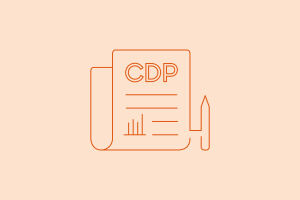A Complete Guide to Customer Data Integration

Collection :
You need to know your customer to deliver the right content, marketing campaigns, and customer experiences at the right time in the buying process. That requires a view of their behavior on your website and on social media, their engagement with email campaigns, and their buying patterns. All this data is stored in various sources across an enterprise – CRMs, website analytics, social media analytics, email analytics, and more. That’s where customer data integration (CDI) comes in – unifying all data about a customer into a single, comprehensive profile.
In order to unify your customer data, you need a clear strategy, an understanding of your data sources, and a customer data platform (CDP) to bring it all together. It may sound daunting, but with the right approach and technology, it’s worth the effort. Once you get everything in place, you’ll see a positive impact across your sales process, marketing campaigns, content delivery, and customer experiences. Branching from several different sources, you can analyze a fully unified customer data profile.
Here’s everything you need to know to get started with your customer data integration journey.
What is customer data integration?
|
Customer data integration (CDI) is the process of consolidating and managing customer data from various sources to create a resolved identity resulting in a 360 view of the customer. |
It involves gathering customer information from multiple data sources like sales, marketing, customer support, and any behavioral interaction, then bringing all those together into a central repository; a customer data platform is one of the best technologies capable of doing this.
The main objective of CDI is to create a unified, reliable, and complete record for each customer, which can be accessed and utilized by different departments and systems across the organization. By having a comprehensive view of customer data, enterprises can enhance customer experiences, improve customer service, and increase revenue through personalized engagement.
Why customer data integration is important
Doing CDI right comes with a long list of benefits. The exact value naturally varies by organization, but there are some universal perks that every industry shares.
Single customer view: CDI creates a unified, consistent view of the customer by consolidating data from multiple sources. This single customer view provides a comprehensive understanding of customer behavior, preferences, and interactions across various touchpoints. It gives your organization a holistic view of each customer, which helps to provide personalized, targeted experiences.
Improved customer experience: By having a complete and accurate view of customer data, you can deliver better customer experiences. You’ll be able to personalize interactions, tailor marketing campaigns, and provide relevant recommendations based on customer preferences, purchase history, and behaviors. This leads to increased customer satisfaction, loyalty, and retention.
Enhanced marketing effectiveness: CDI enables you to segment customer bases effectively and target specific segments with relevant marketing messages. With accurate and up-to-date customer data, your marketing team can create personalized campaigns, deliver targeted offers, and optimize marketing strategies based on customer insights. This improves marketing effectiveness, campaign ROI, and customer engagement, which retailer Sun & Ski Sports experienced firsthand. By aggregating customer data from various sources into one repository and applying machine learning segmentations, Sun & Ski saw a 1,500% increase in response rates for direct mail efforts.
Streamlined sales processes: CDI provides your teams with a clear view of customer data, including purchase history, preferences, and communication records. This helps marketers, sales associates, and customer support representatives understand customer needs, cross-sell or upsell products and services, and provide personalized recommendations. It streamlines sales processes, improves conversion rates, and boosts revenue. For example, luxury leather goods brand MCM Worldwide was able to make more effective personalized product recommendations by digging into data on their customers’ behaviors and buying habits. The result? Personalized emails generated three times the revenue of their “standard” emails.
Data governance and compliance: CDI initiatives often include data governance practices that establish policies, controls, and procedures for managing customer data. This ensures compliance with data protection regulations, maintains data privacy, and establishes data security protocols. It helps your organization meet legal requirements and build customer trust by ensuring their data is in good hands.
Better business insights: By integrating and analyzing customer data from multiple sources, CDI enables you to gain valuable insights into customer behavior, market trends, and business performance. These insights inform data-driven decisions, identify new opportunities, optimize operations, and drive business growth.
The customer data integration process
The CDI process will look different between organizations, but everyone has similar steps to account for. It starts with your goals and data sources. You need to know what data you want, where it comes from, and how it’s structured. From there, you can bring it all together into your CDP, transform data sets to the right schemas, and load unified customer views throughout your martech stack.
Here are the main parts every CDI process should include.
- Define objectives: Start by clearly defining the objectives and goals of the CDI initiative. Determine what specific outcomes you want to achieve through integrating and consolidating customer data. This could include improving customer experiences, enhancing marketing effectiveness, streamlining sales processes, or gaining better insights into customer behavior.
- Identify data sources: Identify the various sources of customer data within your organization. This can include transactional systems, CRM platforms, marketing automation tools, customer support databases, social media platforms, website analytics, and other relevant systems. Determine which data sources are relevant and valuable for creating a comprehensive view of the customer.
- Data mapping and schema design: Understand the structure and format of the customer data from different sources. Develop a data mapping strategy to align and transform the data from various systems into a unified format. Design a data model that can accommodate the different types of customer data, attributes, and relationships.
- Data extraction and transformation: Extract the relevant customer data from each source system according to the defined data mapping strategy. Transform the data to ensure consistency, accuracy, and compatibility with the target CDI system or database. This may involve data cleansing, standardization, deduplication, and normalization processes.
- Data loading and integration: Load the transformed customer data into the target CDI system or database (ideally a capable customer data platform). This will require data integration tools, APIs, or custom data integration workflows to transfer the data and merge it into a unified customer repository. Implement identity resolution techniques to identify and link individual customer records across different sources.
- Data validation and quality assurance: Perform data validation checks to ensure the accuracy and integrity of the integrated customer data. Validate data against predefined business rules, check for data completeness, and resolve any data inconsistencies or errors. Conduct quality assurance tests to verify that the integrated customer data meets the desired standards and requirements. This should be an ongoing process, as customer data doesn’t stop flowing.
- Real-time data access and maintenance: Enable real-time access to the integrated customer data for relevant stakeholders across the organization. Implement mechanisms to ensure that customer data remains accurate and up to date over time. Establish processes for data enrichment, synchronization, and governance to maintain the integrity of the customer data.
- Continuous improvement: CDI isn’t a one and done task; it requires continuous improvement and optimization. Monitor the performance of the CDI system, gather feedback from users, and identify areas for enhancement. Regularly review and update data integration strategies, data quality controls, and data governance processes to adapt to evolving business needs and changing data requirements.
Customer data integration best practices
It’s easy to talk about bringing all your customer data into a single source, but we know it’s complicated. We’ve identified these best practices to avoid CDI trip-ups.
- Start with a clear strategy: Begin with a well-defined CDI strategy that aligns with your business objectives. Clearly outline the goals, desired outcomes, and expected benefits of the CDI initiative. This helps in setting a clear direction and guiding the implementation process.
- Data quality management: Prioritize data quality by implementing data cleansing, validation, and enrichment processes. Regularly monitor and cleanse the integrated customer data to remove duplicates, resolve inconsistencies, and ensure accuracy. Implement data quality controls to maintain data integrity over time.
- Implement data standardization: Standardize data formats, attributes, and values across different data sources. Use consistent naming conventions and data structures to ensure compatibility and easier integration. Standardization facilitates more accurate data mapping and reduces complexities during the integration process.
- Perform data profiling and analysis: Conduct data profiling and analyses to gain insights into the quality, structure, and characteristics of the customer data. Identify data anomalies, patterns, and trends to address data issues proactively.
- Employ identity resolution techniques: Utilize identity resolution techniques to match and merge customer records from different sources. Implement algorithms and methodologies to identify and link duplicate or related customer data. Eliminating data redundancies helps create a more unified customer view.
- Establish data synchronization processes: Implement data synchronization processes to ensure that customer data remains consistent and up to date across various systems and applications. Establish mechanisms for real-time or near-real-time data updates to maintain data integrity and support timely decision-making.
- Conduct regular data audits: Perform periodic data audits to assess the quality, accuracy, and completeness of the integrated customer data. Identify data gaps, inconsistencies, or areas for improvement. Use audit findings to refine CDI processes and enhance data integration practices.
- Monitor and measure performance: Establish key performance indicators (KPIs) to track the performance of the CDI initiative. Monitor data quality, data accuracy, and customer satisfaction metrics. Continuously measure the impact of CDI on business outcomes and make adjustments as needed.
Getting started with customer data integration
CDI may seem like a long journey, but the benefits are worth it. Improved customer experiences across all your digital properties, higher revenue from personalized marketing campaigns, and new insights about customer behavior are just the start. You already have all the data sources and once you have a CDI strategy in place, you just need a central repository. That makes choosing the right CDP a crucial early step in the process.
Acquia CDP takes all of the points from the previous section and accomplishes them for you, taking the heavy lifting off the shoulders of your teams. It also gives organizations the power of personalization and predictive marketing to launch efficient, targeted campaigns. Our CDP includes automated audience segmentation and activation, meaningful content delivery based on
customer profiles, and machine learning models to enhance your marketing capabilities. We’d be happy to talk about how Acquia CDP fits into your CDI strategy. Just reach out to one of our experts to request a demo.



